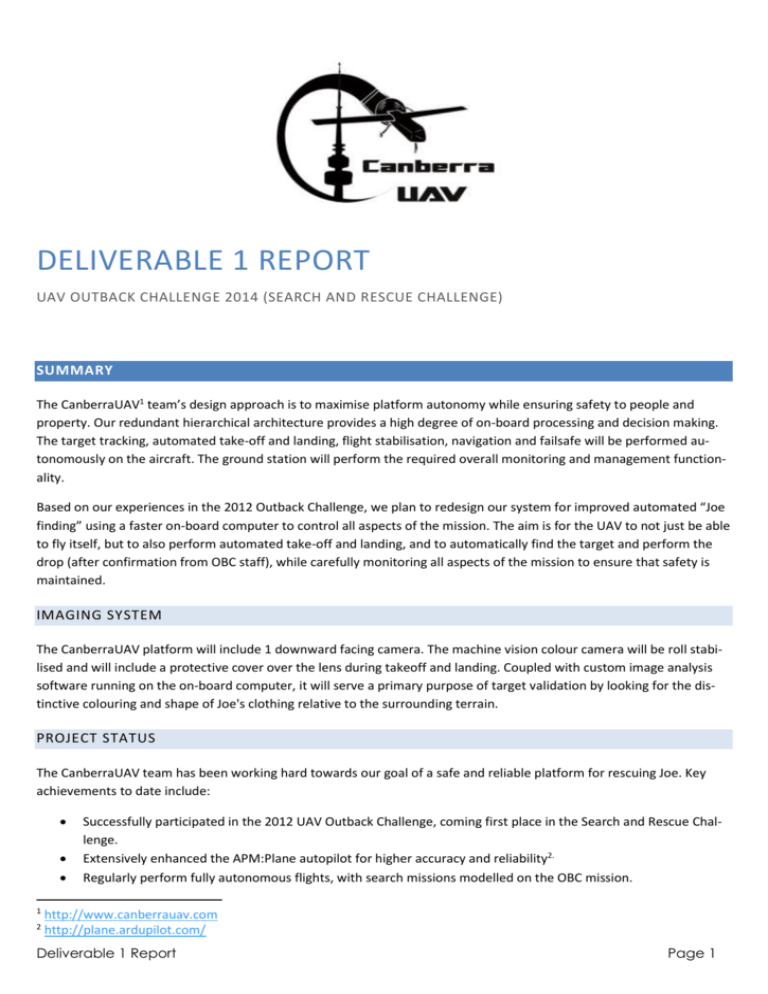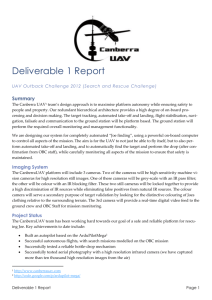Flight Termination (OBC 5.5.1)
advertisement

DELIVERABLE 1 REPORT UAV OUTBACK CHALLENGE 2014 (SEARCH AND RESCUE CHALLENGE) SUMMARY The CanberraUAV1 team’s design approach is to maximise platform autonomy while ensuring safety to people and property. Our redundant hierarchical architecture provides a high degree of on-board processing and decision making. The target tracking, automated take-off and landing, flight stabilisation, navigation and failsafe will be performed autonomously on the aircraft. The ground station will perform the required overall monitoring and management functionality. Based on our experiences in the 2012 Outback Challenge, we plan to redesign our system for improved automated “Joe finding” using a faster on-board computer to control all aspects of the mission. The aim is for the UAV to not just be able to fly itself, but to also perform automated take-off and landing, and to automatically find the target and perform the drop (after confirmation from OBC staff), while carefully monitoring all aspects of the mission to ensure that safety is maintained. IMAGING SYSTEM The CanberraUAV platform will include 1 downward facing camera. The machine vision colour camera will be roll stabilised and will include a protective cover over the lens during takeoff and landing. Coupled with custom image analysis software running on the on-board computer, it will serve a primary purpose of target validation by looking for the distinctive colouring and shape of Joe's clothing relative to the surrounding terrain. PROJECT STATUS The CanberraUAV team has been working hard towards our goal of a safe and reliable platform for rescuing Joe. Key achievements to date include: 1 2 Successfully participated in the 2012 UAV Outback Challenge, coming first place in the Search and Rescue Challenge. Extensively enhanced the APM:Plane autopilot for higher accuracy and reliability2. Regularly perform fully autonomous flights, with search missions modelled on the OBC mission. http://www.canberrauav.com http://plane.ardupilot.com/ Deliverable 1 Report Page 1 Successfully tested a reliable bottle-drop mechanism. Greatly improved the image recognition capabilities of our on-board computer system Built and tested a custom ground control station using a network of several laptops. Demonstrated target acquisition from the air with an accuracy of better than 5m. Designed and built an automated takeoff and landing system into the autopilot software. OVERALL DESIGN OF THE UAV SYSTEM RC RX Module 915 MHz Radio Control and Termination System Servos Power 2 Autopilot On-board Computer 5.8 GHz Radio 915 MHz Radio 5.8 GHz Radio 915 MHz Radio Camera Power 1 RC Transmitter Ground Station Laptops Autopilot – The autopilot will be based on the PX4 hardware platform, running the open source APM:Plane software. The primary connection to the Ground Control Station (GCS) will be via a low-bandwidth 915MHz telemetry and control radio link. A secondary connection to the 5.8 GHz high bandwidth link via the on-board computer will allow for redundancy. On-board computer – A Quad-core ARM embedded computer will be used for image processing, automated Joefinding, drop control, overall on-board mission control and airframe monitoring. It will be connected to the GCS via a high bandwidth 5.8GHz radio link. It will be connected to the autopilot via a high speed serial link. Search camera – One machine vision camera (colour). It will be roll stabilised for a direct downward view. It will be connected to the on-board mission control computer via USB. Control and Termination System (C&TS) – This will be based on the PX4IO board with a custom firmware. When a failsafe criterion is satisfied, or when commanded, this will initiate the termination program with fixed servo settings as per Deliverable 1 Report Page 2 OBC rules 5.6. It will also accept input from RC controller pilot when in visual range. The flight termination will take priority over RC control. The PX4 IO board will be separately powered from other systems. Low-bandwidth link – The telemetry and control link will use the MAVLink3 (Micro-Aerial-Vehicle link) protocol, over a RFD900 ISM band telemetry radio. The RFD900 operates in the 915 to 928MHz band, under LIPD-2000 item 45 rules. High-bandwidth link – A TDMA Ubiquity digital radio with antenna tracking, using the 5.8GHz class license under LIPD2000 item 45B rules. The radio will be running an IP link carrying digital video, MAVLink telemetry and mission control commands to and from the GCS. Ground Control Station – A custom GCS connected via both low and high-bandwidth links to the plane. The GCS provides NMEA GPS and video feeds to OBC organisers. Control and monitoring of all aspects of mission. The GCS will report all waypoint crossings and other key mission parameters via audible announcements. RC control – A standard “C-tick” 2.4GHz RC transmitter and receiver for visual range control. AIRCRAFT SPECIFICATIONS (OBC 5.1) NOTE: In this section references to S&R rules sections will be indicated via “OBC x.y.z” The aircraft will be a custom fixed-wing airframe with an approximately 3m wingspan and maximum take-off weight less than 20 kg. The aircraft itself will be a conventional fixed wing airframe with an internal combustion engine, but will use avionics and control systems developed by the CanberraUAV team, with assistance from the open-source community. The aircraft is capable of autonomous flight via on-board autopilot and on-board computer. The aircraft will have continuous communication with the UAV controller on the ground via multiple radio links, on separate frequencies from the RC transmitter. One radio link will be to the autopilot and the other to the on-board computer. Either link will be sufficient for full control, monitoring of the aircraft and completion of the mission. The mission will be conducted at an altitude of approximately 400 feet, except for take-off and landing. If testing shows that flying between 400 and 1500 feet improves mission performance, we will apply for permission and will adjust the mission accordingly. SAFETY FIRST (OBC 3) The team will comply with CASR-101, but will additionally stress safety first, and will not fly unless we are sure it is safe to do so. We have made contact with our local CASA office to inform them of our activities and ensure compliance. PILOT PROFICIENCY (OBC 5.2) Two team members hold MAAA4 (Model Aircraft Association Australia) gold-wings. The team has more than 50 years of aeromodelling experience between them. The primary pilot also holds a pilots certificate with cross-country endorsement. PRE-FLIGHT TESTS (OBC 5.3) The team will use a combination of automated and manual checklists, physical inspection and testing to ensure all systems are operating correctly before flight. The GCS will display and report system status of all connected systems, and warn of any issues. 3 4 http://www.qgroundcontrol.org/mavlink/start http://www.maaa.asn.au/ Deliverable 1 Report Page 3 RADIO FREQUENCIES (OBC 5.3.1/5.3.2) While the team has two Australian licensed HAM radio operators, we do not at this stage anticipate needing special licensing beyond ACMA class licenses. All radio communication will be digital, including the video link. We currently expect to use: 915-928 MHz band for low-bandwidth digital telemetry and control link 2.4GHz band for visual range RC control (ACCST or similar) 5.8GHz band for high-bandwidth digital data link (Ubiquity TDMA) The team is actively testing radio configurations and will adjust antenna and radio links based on test results and EIRP requirements. RC OVERRIDE (OBC 5.4) The RC override by the safety pilot will only be possible within visual range. Flight termination activation will take priority over RC override. Takeoff and landing will be under autopilot control, with the option of manual takeoff or landing at the discretion of the pilot. RC takeover and “stick mixing” will be used to allow instant override by the pilot without any intervention by the ground station operators. FLIGHT TERMINATION (OBC 5.5.1) We are developing a custom C&TS system based on the PX4 IO board. This board is a standard part of the PX4 autopilot system, which CanberraUAV has been heavily involved in the development of over the last year. The PX4 IO board will have custom firmware to provide support for all failsafe functionality of the Outback Challenge. The C&TS will be independently powered and will implement the primary OBC S&R FTS option using fixed maximum servo positions. The C&TS will monitor the autopilot, plus the RC receiver, and will be the sole controller of flight surface servos. Flight termination activation will proceed as per the following sections. Flight termination can be initiated by the GCS through controls to the autopilots. If the C&TS system fails, flight termination will be immediately initiated. LOSS OF DATA LINK (OBC 5.5.2) The UAV will monitor data link integrity of both the high and low-bandwidth links via MAVLink heartbeat messages sent from the GCS at a rate of 2Hz. On loss of data link for 10 seconds, the aircraft will proceed to the comms hold waypoint. After 2 minutes at the comms hold waypoint the aircraft will navigate to airfield home and loiter. If data link is not reestablished after 2 minutes at airfield home and RC control is not possible by the pilot, flight termination will be initiated. If RC control is possible the pilot will land the plane. Loss of GPS at the same time as data link loss will cause flight termination. ENGINE FAILURE (OBC 5.5.3) The UAV will have electronic engine monitoring. In case of engine failure, the UAV will initiate a controlled glide towards airfield home. The pilot will be able to control the glide via the RC transmitter if in visual range. LOSS OF GPS POSITION (OBC 5.5.4) Loss of GPS position will switch the autopilot into a dead-reckoning mode which fuses sensor information from the compass, airspeed sensor and IMU to estimate position. In GPS failure mode the plane will circle while maintaining current altitude for 30 seconds, waiting for GPS signal. If there is no signal after 30 seconds then the autopilot will start dead-reckoning direct to airfield home waypoint. Deliverable 1 Report Page 4 GEO-FENCING (OBC 5.5.5) The autopilot will continually monitor mission boundary compliance via a GPS device. If the autopilot detects a mission boundary violation it will raise a signal on the C&TS, which will initiate flight termination. Mission boundary detection will be via the standard even-odd ray-casting rule for polygons. Mission boundary edges will be programmed into the autopilots non-volatile memory and checked during pre-flight preparation, as well as displayed on the ground station for operator monitoring. Audible warnings of approach of the geo-fence boundary will be used while under manual control during scrutineering. Vertical boundary detection will be via barometric pressure with ground reference pressure updated during flight by a 2nd barometer attached to the ground station. Compliance with AMSL pressure altitude limits will be performed by the autopilot and will trigger flight termination if breached. AUTOPILOT LOCK-UP (OBC 5.5.6) The autopilot will provide a 10 Hz heartbeat signal to the C&TS system. Lack of heartbeat for 0.4 seconds will cause the C&TS to initiate flight termination. FAILURE OF GROUND CONTROL STATION (OBC 5.5.7) If the autopilot detects no communications heartbeat signal from the GCS for a period of 10 seconds then the loss of data link procedure will be initiated. ADDITIONAL SYSTEMS (OBC 5.5.8/5.6.2) A stability augmentation system will not be required for safe manual flight control and will not be used during the pilot proficiency assessment. The aircraft will not use any pyrotechnic devices. LIABILITY AND INSURANCE (OBC 5.11) Testing to this point has been at a MAAA insured site, staying within MAAA rules. We will obtain appropriate team insurance for both flight testing and competition flights. VIDEO STREAM FROM UAV (OBC 5.14) A digital video stream from the aircraft will be available on the GCS based on the available radio bandwidth over the 5.8GHz link. The video stream will be low priority, and will cease if RF interference causes the radio link to degrade. In addition a moving map representing the UAV’s progress through the mission will be displayed over satellite imagery. A NMEA 0183 GPS serial stream will be provided for use by the OBC organisers. BATTERY MANAGEMENT (OBC 5.16) The aircraft will not use any LiPo batteries. We will be using safer LiFePO4 or NiMH cells for all on-board electronics. AERONAUTICS (OBC 3.2) In preparation for OBC 2014 we have implemented monitoring of airspeed sensor status and airspeed sensor calibration. During flight the autopilot will monitor the consistency of airspeed data with IMU and GPS data and will fall back to Deliverable 1 Report Page 5 alternative algorithms as needed to ensure the aircraft maintains sufficient airspeed to prevent a stall. During flight testing we will measure the stall speed under full load for calibration of the autopilot. RISK ASSESSMENT Failure Mode Mitigation Insurance Airframe Operation Airframe Installation Range Safety Engine Fuel Electrical power Connections, wiring and soldering Autopilot Geofencing system failure Air traffic Uncommanded release of payload Fly away of aircraft Rescue of lost aircraft Bugs in software Configuration management Deliverable 1 Report Preliminary work will be carried out at our local model aircraft field under MAAA procedures with MAAA insurance, and the regular critique of fellow modellers. Extensive testing will be carried out at a private property near Canberra, within the one year span of appropriate insurance. Operation to be in line with MAAA procedures Competition aircraft and pilots to obtain MAAA heavy model certificate before flight of competition aircraft. We will develop a range safety plan appropriate for each site. For the MAAA field we will use the MAAA Manual of Procedures. For our long range test site, we will develop appropriate range procedures, with a designated range safety officer. Starting and operation to be in line with MAAA procedures Engine starting procedure to follow general aviation practice. Stopping of engine to be by removing power to the ignition. Petrol will be contained in a strong container to resist bursting on impact, containing only enough fuel to carry out the mission with adequate reserve. Appropriate safety procedures will be implemented for transport and storage. Separate battery packs for Primary control system, instrumentation and C&TS. Batteries to be NiMH or Lithium Iron Phosphate. No LiPo. Batteries to be of capacity adequate for mission with reserve. To be carried out by experienced electronics technician with years of experience in model aircraft and marine electronics in the field. Loss of the heartbeat throughout software (written by a professional programmer) will signal failure to the C&TS. Failure of the system running the geofencing program will alert the control and termination system by loss of the heartbeat. Radio watch will be held by pilot in charge during trials at the test range by an experienced aviation pilot. Flight altitude will not exceed 400 AMSL. Prior contact will be made with local gyrocopter pilots. The release mechanism will require both an arming signal from ground control and a release signal from the on board computer to release. Extensive practice at test range to OBC rules (including geo-fencing), but with a soft termination to be carried out by the C&TS. Procedures to be put in place by our experienced bushwalker prior to field testing. Only Outback Joe will be left alone in the field. Will use Hardware In Loop (HIL) and Software In The Loop (SITL) simulation testing to verify software and autopilot hardware, and reduce risk of software bugs. We are using best software industry practice for configuration management and software version control. Page 6






